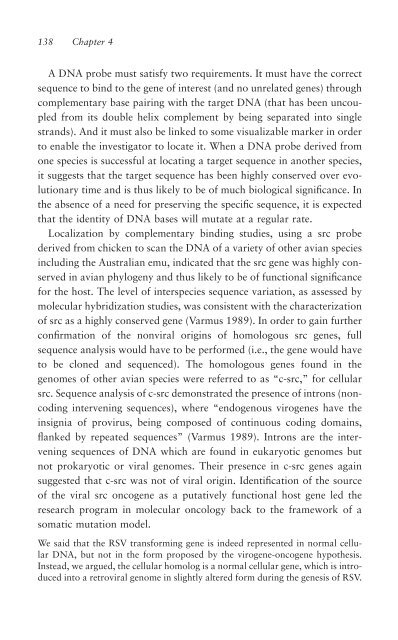A Critique of Pure (Genetic) Information
A Critique of Pure (Genetic) Information
A Critique of Pure (Genetic) Information
Create successful ePaper yourself
Turn your PDF publications into a flip-book with our unique Google optimized e-Paper software.
138 Chapter 4<br />
A DNA probe must satisfy two requirements. It must have the correct<br />
sequence to bind to the gene <strong>of</strong> interest (and no unrelated genes) through<br />
complementary base pairing with the target DNA (that has been uncoupled<br />
from its double helix complement by being separated into single<br />
strands). And it must also be linked to some visualizable marker in order<br />
to enable the investigator to locate it. When a DNA probe derived from<br />
one species is successful at locating a target sequence in another species,<br />
it suggests that the target sequence has been highly conserved over evolutionary<br />
time and is thus likely to be <strong>of</strong> much biological significance. In<br />
the absence <strong>of</strong> a need for preserving the specific sequence, it is expected<br />
that the identity <strong>of</strong> DNA bases will mutate at a regular rate.<br />
Localization by complementary binding studies, using a src probe<br />
derived from chicken to scan the DNA <strong>of</strong> a variety <strong>of</strong> other avian species<br />
including the Australian emu, indicated that the src gene was highly conserved<br />
in avian phylogeny and thus likely to be <strong>of</strong> functional significance<br />
for the host. The level <strong>of</strong> interspecies sequence variation, as assessed by<br />
molecular hybridization studies, was consistent with the characterization<br />
<strong>of</strong> src as a highly conserved gene (Varmus 1989). In order to gain further<br />
confirmation <strong>of</strong> the nonviral origins <strong>of</strong> homologous src genes, full<br />
sequence analysis would have to be performed (i.e., the gene would have<br />
to be cloned and sequenced). The homologous genes found in the<br />
genomes <strong>of</strong> other avian species were referred to as “c-src,” for cellular<br />
src. Sequence analysis <strong>of</strong> c-src demonstrated the presence <strong>of</strong> introns (noncoding<br />
intervening sequences), where “endogenous virogenes have the<br />
insignia <strong>of</strong> provirus, being composed <strong>of</strong> continuous coding domains,<br />
flanked by repeated sequences” (Varmus 1989). Introns are the intervening<br />
sequences <strong>of</strong> DNA which are found in eukaryotic genomes but<br />
not prokaryotic or viral genomes. Their presence in c-src genes again<br />
suggested that c-src was not <strong>of</strong> viral origin. Identification <strong>of</strong> the source<br />
<strong>of</strong> the viral src oncogene as a putatively functional host gene led the<br />
research program in molecular oncology back to the framework <strong>of</strong> a<br />
somatic mutation model.<br />
We said that the RSV transforming gene is indeed represented in normal cellular<br />
DNA, but not in the form proposed by the virogene-oncogene hypothesis.<br />
Instead, we argued, the cellular homolog is a normal cellular gene, which is introduced<br />
into a retroviral genome in slightly altered form during the genesis <strong>of</strong> RSV.
















